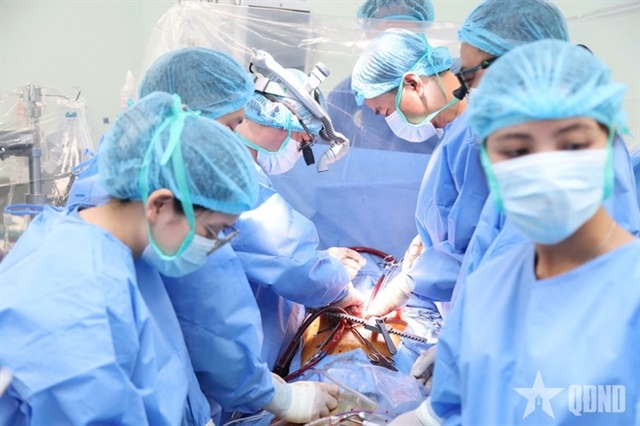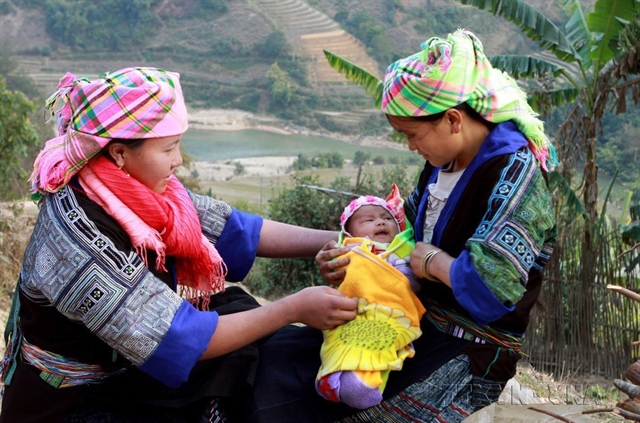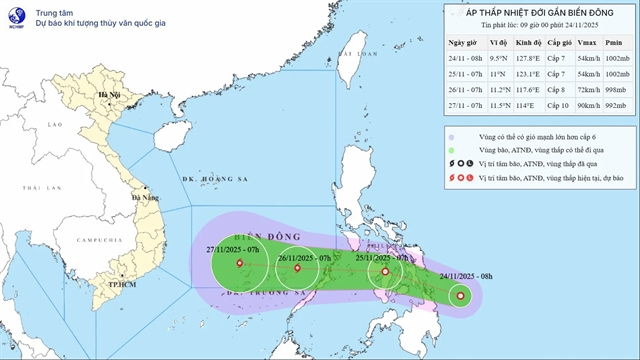 Society
Society


|
| Thào Thị Pà shares her experience as a village midwife during a recent ceremony to launch Safe Motherhood Week 2025. VNA/VNS Photos |
LÀO CAI — Many remote villages in Việt Nam once relied on home births and outdated practices. Today, thanks to the dedication of village midwives, maternal health in these areas has improved dramatically.
In Pờ Sì Ngài Hamlet, Bản Xèo Commune, northern Lào Cai Province, Thào Thị Pà, an ethnic Mông woman, has served as a village midwife since 2011. At that time, travel conditions were extremely difficult.
Every trip for prenatal check-ups or delivery was a major challenge. Slippery roads during the rainy season, dense fog in winter and limited vehicle access forced locals to take trails, climb slopes and wade through streams.
Most mothers still gave birth at home according to long-standing customs. Out of 10 births, nine took place inside houses or even in field huts, posing high risks for both mother and baby. Many families also relied on rituals, neglecting the importance of regular prenatal care.
Pà patiently visited each household, explaining the benefits of prenatal check-ups and persuading expectant mothers to give birth at medical facilities. Her persistence has yielded visible results. Today, up to 80 per cent of pregnant women in the hamlet receive regular check-ups, 70 per cent of deliveries are assisted by health workers and 90 per cent of mothers and newborns receive postnatal care.
Local woman Thào Thị Dế was initially urged by her family to give birth at home. After repeated persuasion, they finally agreed to let Pà take Dế to the local health station. Only when the baby was safely born did Pà breathe a sigh of relief.
Also in Lào Cai, Lục Thị Lỳ, an ethnic Nùng woman, has served as the midwife of Na Vai Hamlet, Bản Lầu Commune, since 2019. At that time, around half of the mothers in the hamlet still gave birth at home.
What troubled her most was the persistence of outdated practices, with many families believing ancestral rituals were enough or thinking.
“Our mothers and grandmothers already gave birth at home without problems,” she said.
Refusing to accept such customs, Lỳ visited households repeatedly, explaining that giving birth at a health facility meant having doctors, medicine and equipment for safety. Some families required multiple visits and long conversations before changing their minds.
Many nights she returned home late in cold and darkness, but reminded herself that any effort was worth it if people were willing to change. Lỳ also holds village meetings and women’s gatherings to promote knowledge about pregnancy care, nutrition, rest, tetanus vaccination and recognising abnormal signs for timely check-ups.
In Na Vai Hamlet, every mother is visited at least three times after giving birth. Lỳ carefully guides them on nutrition, exclusive breastfeeding for the first six months and monitoring newborn health. She also advises families against restrictive diets that weaken mothers, encouraging varied and nutritious meals to aid recovery and lactation. She teaches proper newborn care, such as light clothing and swaddling without binding arms.
Thanks to her tireless efforts, 98 per cent of pregnant women in the hamlet now receive regular check-ups. All deliveries are assisted by health workers, and all mothers and newborns receive postnatal care.
Lỳ said being a village midwife is both a responsibility and an act of love. Despite modest allowances, she often spends her own money on fuel, raincoats, boots or small gifts to encourage mothers and newborns.
“I hope health sector will provide more training, increase allowances and support transportation and protective gear so that village health workers can continue serving their communities,” she told Vietnam News Agency.
More than 30 years since the first training courses for village midwives, these dedicated women still brave hardships to visit households, raise awareness and persuade people to abandon harmful customs.
According to the Ministry of Health, Việt Nam’s maternal and child health care has seen significant progress, highly recognised internationally. Maternal mortality has dropped more than fivefold, from 233 per 100,000 live births in 1990 to about 44 per 100,000 in 2024, ranking fourth in Southeast Asia.

|
| A village midwife (left) instructs a mother how to take care of the baby in Lào Cai Province. |
Infant mortality under one year has decreased more than fourfold, while under-five mortality has nearly been cut by four times.
Still, the gap remains wide compared with developed countries.
Disparities among regions are also stark. Maternal mortality among Mông women is more than seven times higher than among Kinh and Tày women.
Provinces such as Lai Châu, Điện Biên, Hà Giang, Kon Tum, Đắk Nông and Lào Cai report maternal and child mortality rates two to three times higher than the national average, mainly due to limited access to health services, uneven service quality and outdated customs.
To address this, the Government has directed the health sector and localities to implement multiple interventions, expand maternity care services and strengthen grassroots health workers.
This year, Safe Motherhood Week has been launched by the Ministry of Health, lasting from October 1–7, with the theme 'Comprehensive postpartum care – Health for mothers, future for children.'
During the week, provinces and cities have carried out communications campaigns and mobilised the participation of communities and local authorities to raise awareness and promote social responsibility in maternal and child care.
The health sector will also continue its programme to reduce under-five mortality by 2030, to leave no mother or child behind.
Deputy Minister of Health Nguyễn Trí Thức stressed that care, support and active participation from the whole of society will contribute to improving maternal and child health and further reducing maternal and child mortality in Việt Nam.
Alongside policies, family and community involvement and support from the health system, it is the persistence and devotion of village midwives that help eliminate outdated customs and write a new chapter towards a healthier future for mothers and children in Việt Nam, he said. — VNS




